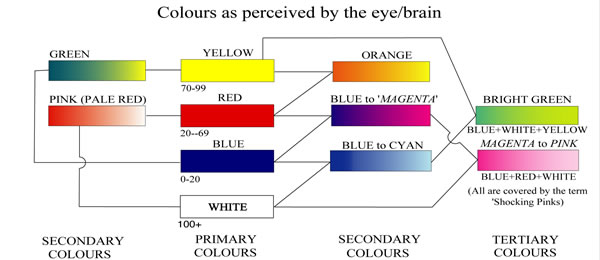-
The Origin of Colour – New Research
Posted on July 3rd, 2009 No commentsThe retinal cones can differentiate 4 different energy/velocity ranges which the brain interprets as the colours Blue, Red, Yellow and White. Light ‘particles’ entering the cone and having sufficient energy to pass through to the 4th compartment are assessed by the brain to be ‘White’ light. Any light passing into the 1st compartment but without sufficient energy to pass into the second will be assessed as ‘Blue’ light. Similarly with the ‘Red” and ‘Yellow’ compartments.
 Although this may appear to be too simple to explain the wide range of colours and shades, in fact it explains all of them. It also provides the explanation of ‘Colour Blindness’, which I considered essential to any theory of colour. Yes I am aware that the above simplified version of the retinal cone is very little like a real retinal cone. The real cone is a very messy looking unit that could do with a bit of engineering updating, but it does do what it was designed to do. Although the shapes and sizes of individual cones may widely vary, the human brain can adjust the information in the same way that a good pianist can play a badly tuned piano.
Although this may appear to be too simple to explain the wide range of colours and shades, in fact it explains all of them. It also provides the explanation of ‘Colour Blindness’, which I considered essential to any theory of colour. Yes I am aware that the above simplified version of the retinal cone is very little like a real retinal cone. The real cone is a very messy looking unit that could do with a bit of engineering updating, but it does do what it was designed to do. Although the shapes and sizes of individual cones may widely vary, the human brain can adjust the information in the same way that a good pianist can play a badly tuned piano.
Colours as Perceived by the Eye and Brain
The addition of two colours of different energy levels creates turbulence in the ‘cones’. Where Blue and White are mixed as in Cyan, Bright Green and Magenta Pinks, this creates the greatest turbulence which is irritating to the eye. Lesser energy differentials such as Yellow and Blue (as in the natural Greens) give a more gentle turbulence which is soothing to the eye. It should be realised that the ‘True’ Primary colours actually cover a range of energy levels, i.e. in the ‘true’ Red above the range is shown as 20-69 (hypothetical energy units). This means that light having energy in this range will be perceived as ‘true’ Red. Colour ‘Blindness’ is due to either chemical differences in the cone fluid altering the resistance to the passage of light and therefore changing the section of the cone into which it finally arrives, or may be due to actual physical differences in the cones. The effect of the actual energy level will only become apparent when combined/mixed with other Primary colours. It should be realised that the ‘Wave Hypothesis of Light’ is unable to explain any of the colour phenomena, because the mixing or combining of colours would destroy any ‘frequency’ involved in light. There is also the fact that the eye is confused by frequencies above 15-20 cycles/sec, yet the physicists argue that the eye operates at approx 10,000,000,000,000,000 cycles/sec. See also Newton’s Colour Wheel, Taper Slit Experiment, Taper Silhouette Experiment. First published July 3rd 2009
Brian Williams – Author

